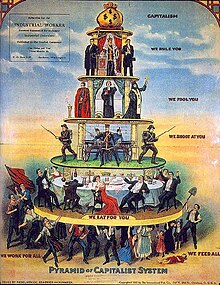Pyramid of Capitalist System


The Pyramid of Capitalist System is a common name of a 1911 American cartoon caricature critical of capitalism, closely based on a Russian flyer of c. 1900.[1] The graphic focus is on social stratification by social class and economic inequality.[2][3] The work has been described as "famous",[4] "well-known and widely reproduced".[2] A number of derivative works exist.[5][original research?]
It was published in the 1911 edition of Industrial Worker (The International Publishing Co., Cleveland, Ohio, U.S.), a newspaper of the Industrial Workers of the World, and attributed to "Nedeljkovich, Brashich, & Kuharich".[6][7][3]
The picture shows a literal "social pyramid" or hierarchy, with the wealthy few on the top, and the impoverished masses at the bottom. Crowned with a money bag representing capitalism, the top layer, "we rule you", is occupied by the royalty and state leaders. Underneath them are the clergy ("we fool you"), followed by the military ("we shoot at you"), and the bourgeoisie ("we eat for you"). The bottom of the pyramid is held by the workers ("we work for all... we feed all").[4][8][3][2]
The work is based on an anonymous 1900 caricature of the Russian Empire hierarchy by the Union of Russian Socialists.[1][9] The original picture showed workers supporting the pyramid on their backs, with the stanza: "The time will come when the people in their fury will straighten their bent backs and bring down the structure with one mighty push of their shoulders."[1] Notable differences between the Russian 1900 original and the American 1911 derivative version include the replacement of the Russian Empire's black eagle with a money bag, the Russian tsar and tsarina with a more generic trio of figures (a monarch and state leaders in suits), two of the three Orthodox clergy with a Catholic cardinal and a Protestant minister, and the Russian Empire army with a more generic group of soldiers; the workers are no longer bent and no revolutionary stanza is present. On both pictures, a fallen child or child worker symbolizes the plight of the workers.[2] Another shared element is a red flag raised amongst the workers, symbolizing the emergence of the socialist movement.[10]
The basic message of the image is the critique of the capitalist system, with its hierarchy of power and wealth. It also illustrates that the working class is supporting all others, and if it would withdraw their support from the system it could, literally, topple the existing social order.[3] This type of criticism of capitalism is attributed to the French socialist Louis Blanc.[4]
References
- ^ a b c Reinhard Bendix (1980). Kings Or People: Power and the Mandate to Rule. University of California Press. p. 540. ISBN 978-0-520-04090-8.
- ^ a b c d Krieger, N (1 December 2008). "Ladders, pyramids and champagne: the iconography of health inequities". Journal of Epidemiology & Community Health. 62 (12): 1098–1104. doi:10.1136/jech.2008.079061.
- ^ a b c d "Labor Arts". Labor Arts. Retrieved 2014-04-16.
- ^ a b c Geoff Mulgan (27 February 2013). The Locust and the Bee: Predators and Creators in Capitalism's Future. Princeton University Press. pp. 79–80. ISBN 1-4008-4665-X.
- ^ Consider a number of modern derivative works found at the following websites:
- "Staines Anarchists Pyramid Poster | stainesanarchists". Stainesanarchists.wordpress.com. 2012-06-29. Retrieved 2014-04-16.,
- "The Pyramid of Capitalism". Speldwright.com. Retrieved 2014-04-16.,
- "Capitalist society poster". Libcom.org. 2010-12-27. Retrieved 2014-04-16.,
- "CWC Books : Work, capitalism . economics . resistance". Crimethinc.com. 2011-05-22. Retrieved 2014-04-16.
- ^ Nancy Krieger Professor Harvard School of Public Health (23 March 2011). Epidemiology and the People's Health : Theory and Context: Theory and Context. Oxford University Press. pp. 338–. ISBN 978-0-19-975035-1.
- ^ Kristina Lange (2011). Historisches Bildverstehen oder Wie lernen Schüler mit Bildquellen?: ein Beitrag zur geschichtsdidaktischen Lehr-Lern-Forschung. LIT Verlag Münster. pp. 189–. ISBN 978-3-643-11354-2.
- ^ John A. Marino (2002). Early Modern History and the Social Sciences: Testing the Limits of Braudel's Mediterranean. Truman State Univ Press. p. 121. ISBN 978-1-931112-06-2.
- ^ Ronald Hingley (1 March 1972). A concise history of Russia. Viking Press.
- ^ Rune Nordin (1981). Fackföreningsrörelsen i Sverige: Uppkomst och utveckling (in Swedish). Prisma i samarbete med Landsorganisationen i Sverige. p. 28. ISBN 978-91-518-1470-4.
